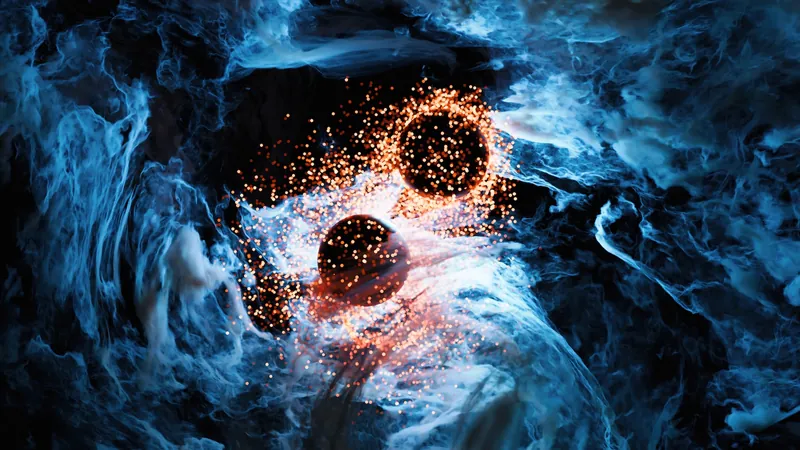
A Revolutionary Step Toward the 'Theory of Everything': Rethinking Einstein's Gravity
2025-05-15
Author: Mei
Unifying Gravity and Quantum Physics: A Bold New Approach
Physicists are breaking new ground in the quest to solve a critical puzzle in theoretical physics: how to unite the forces of gravity with the quantum realm. In a groundbreaking paper published in *Reports on Progress in Physics*, researchers have proposed a fresh reformulation of gravity that could pave the way for a fully quantum-compatible theory — all without resorting to the complex extra dimensions of string theory.
A New Interpretation of Gravity
Central to this revolutionary idea is a re-evaluation of gravity’s fundamental behavior. While our understanding of electromagnetic, weak, and strong forces is well-captured by quantum field theory, gravity has long remained an anomaly. Einstein’s general relativity frames gravity as the warping of space-time by mass and energy. However, merging this classical view with quantum theory has historically led to frustrating mathematical inconsistencies.
The innovative approach from this research team reinterprets gravitational fields in a manner reminiscent of established quantum field theories. Co-author Mikko Partanen, a physicist at Aalto University, noted, The key finding is that our theory resembles the formulation of the other fundamental interactions of the Standard Model.
Four Interrelated Fields: A Game Changer?
Rather than bending space-time, this novel model proposes that gravity is mediated by four interconnected fields, akin to the fields tackling electromagnetism. These fields react to mass similarly to how electric and magnetic fields respond to charge and current, while also interacting with the Standard Model's forces. The result mimics general relativity classically while seamlessly integrating quantum effects.
Simplifying Complexity: Why This Approach Stands Out
One of the most striking advantages of this theory is its simplicity. It diverges from many contemporary models of quantum gravity that rely on hypothetical particles and mysterious forces. According to co-author Jukka Tulkki, Our theory eliminates the need for unproven extra dimensions and doesn’t involve any free parameters beyond those already known. This means that future experiments could directly test the predictions without waiting for the discovery of new particles.
The Road Ahead: Challenges and Opportunities
While the framework shows promising early results, it is still in an exploratory phase. Ongoing calculations suggest that it holds up under initial scrutiny; however, a complete validation of its consistency remains necessary. Furthermore, significant gravitational questions – like the true nature of black hole singularities and the physics surrounding the Big Bang – are yet to be fully addressed.
Experimental challenges abound as well. Since gravity is the weakest of the known forces, observing its quantum nature is exceptionally difficult. Tulkki emphasizes that, despite these hurdles, the absence of adjustable parameters means any future experiments exploring quantum gravitational behavior could definitively confirm or dismiss this novel proposal.
Looking Forward to the Future of Quantum Gravity
The potential for significant advancements in understanding quantum gravity is substantial, though breakthroughs may take decades. Partanen remarks that while direct evidence may be slow to surface, indirect evidence through advanced observations may arrive sooner.
For now, Partanen and Tulkki's pioneering work marks an exciting new chapter for theorists striving to unlock the mysteries of quantum gravity, grounded firmly in the established frameworks of particle physics — a step closer to unraveling the universe’s most profound secrets.




 Brasil (PT)
Brasil (PT)
 Canada (EN)
Canada (EN)
 Chile (ES)
Chile (ES)
 Česko (CS)
Česko (CS)
 대한민국 (KO)
대한민국 (KO)
 España (ES)
España (ES)
 France (FR)
France (FR)
 Hong Kong (EN)
Hong Kong (EN)
 Italia (IT)
Italia (IT)
 日本 (JA)
日本 (JA)
 Magyarország (HU)
Magyarország (HU)
 Norge (NO)
Norge (NO)
 Polska (PL)
Polska (PL)
 Schweiz (DE)
Schweiz (DE)
 Singapore (EN)
Singapore (EN)
 Sverige (SV)
Sverige (SV)
 Suomi (FI)
Suomi (FI)
 Türkiye (TR)
Türkiye (TR)
 الإمارات العربية المتحدة (AR)
الإمارات العربية المتحدة (AR)